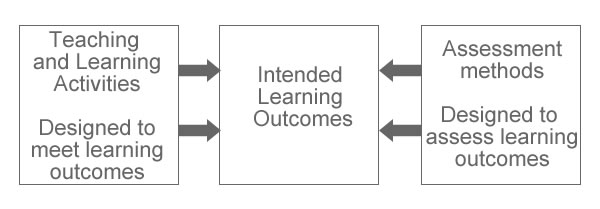How do I plan my teaching?
Getting started
 Orientation
Orientation
- How do I plan a good teaching session?
- What is the meaning and importance of 'alignment'?
- How do I know I've got the relationship between learning outcomes, learning activities and assessment right?
One way to start to think about a competent use of teaching and learning methodologies to engage students is to consider the lecture. When it is done well, lecturing can be an effective means of engaging students. However, avoiding common mistakes involves planning lectures to ensure that the lecture engages students.
If you visited the website above on planning lectures, you will have seen that a range of factors have to be taken into account in order to deliver an effective lecture. By extension, the same is true for all forms of teaching. These factors can be divided into two groups: effective planning (this section) and effective delivery of teaching to engage students (next section).
One way to plan your teaching is to ensure that the three elements of the teaching process - learning outcomes, teaching and learning activities, and student assessment - are aligned. When this happens there are clear and logical relations between learning outcomes (what you want students to know, understand, be able to do), learning activities (tasks, interactions etc. to enable students to achieve outcomes) and student assessment (to measure whether students have achieved the intended outcomes).

 Reflection
Reflection
Think about your own teaching and this concept of alignment.
Are the learning outcomes clear?
Do the teaching and learning activities support students to achieve those outcomes?
Does the assessment actually measure what it is meant to measure?
Alignment
Writing learning outcomes is covered in much more detail in the section How do I write clear learning outcomes for a course? This section is designed as an introduction to the topic.
We want students to learn certain "things". These "things" might be basic facts, complicated theories or particular skills. No matter what we want our students to learn, we need to tell our students what we expect them to know, understand and be able to do by the end of a particular teaching session. That's why we write learning outcomes. Learning outcomes are also referred to as learning objectives. The terms are often used interchangeably.
Learning outcomes are statements that describe what a student is expected to know, understand and be able to do by the end of the course. Learning outcomes orient students to content, helping them to make sense of what is presented. Learning outcomes also allow students to make judgements about whether they have learned what they need to learn.
How to Write Learning OutcomesWhen writing outcomes, always start with a stem, such as:
'At the end of this session, learners will be able to ...'
then use a verb, that states specifically what the learners will be able to do, e.g.
'...demonstrate...'
followed by a clear statement of the topic of interest
'...that they can administer an intramuscular injection'.
You can visit the University of Nottingham website and/or the London Deanery website for further guidelines on writing learning objectives.
We can write learning outcomes for three domains: knowledge (cognitive domain), skills (psychomotor domain) and attitudes (affective domain). Learning outcomes within these domains can be categorised into hierarchical levels. For example, learning outcomes in the cognitive domain can range from the lowest level of factual recall (which can be very important) to the higher level of evaluation and application of knowledge in a new context (also very important). The University of Newcastle website provides a very clear explanation of the different levels of learning in the cognitive domain.
Anuj Bhargava on planning your class and having clear learning outcomes:
![]() Click to view the video (Flash Player is required).
Click to view the video (Flash Player is required).
 Reflection
Reflection
Take a good look at the learning outcomes that you use in your own teaching.
Have you followed the guidelines for writing learning outcomes?
What level of learning are you demanding from your students?
Is the level of learning appropriate for e.g. undergraduate students, postgraduate students?
Teaching and Learning Activities
Teaching and learning activities are the activities that you design to help your students achieve the intended learning outcomes for the course. Teaching and learning activities include but are not limited to:
- delivering a lecture;
- holding a tutorial;
- engaging students in a collaborative learning exercises;;
- having a student work with a patient or client;
- having a student practice a clinical skill on a model, mannekin or patient simulator.
The key point here is that the design of the teaching and learning activities is driven by the intended learning outcomes. For example, if we write learning outcomes that require our students to demonstrate higher order thinking and/or to master a particular skill, then we need to design teaching and learning activities that will help students to achieve these outcomes. Examples of teaching and learning activities that encourage higher order thinking might include a mini-lab project, or a case study that requires students to draw on knowledge from different areas of the curriculum. Examples of activities that can help students to master a skill include demonstration coupled with practice activities on e.g. a human patient simulator with reinforcement through watching the skill performed in a video clip.
 Reflection
Reflection
What sorts of teaching and learning activities have you designed to help your students achieve the learning outcomes? Is there a match between outcomes and activities?
Assessment
Students and teachers both need to know that the desired learning outcomes have been achieved. We measure learning by assessing our students - generally in two ways:
- Formative assessment: We might assess students during a course without formally grading them. The purpose of formative assessment is to let students know how they are doing and to provide them with constructive feedback so that they can improve. This might entail giving feedback on a draft piece of written work or giving feedback as students perform a clinical skill or practical procedure in the laboratory.
- Summative assessment: Summative assessment is designed to measure whether students have achieved the stated learning outcomes and the assessment is associated with a grade or mark.
When we write an assessment we have to ensure that it is reliable and valid.
A reliable assessment is one in which the same students would consistently achieve the same results or in which different teachers would grade in the same way. This definition of reliability can sound odd at first. What we mean here is that the assessment has been written in such a way that expectations of what is required (assessment criteria) are clear, marking schemes have been clearly defined and questions are unambiguous. When we achieve these aims, we remove the possibility that a feature of the assessment itself might produce an inconsistent result.
A valid assessment is one that measures what it is supposed to measure. For example, if we have a learning outcome such as, "Students will be able to state the different categories of amino acid" then the assessment has to measure the student's ability to state the different categories of amino acid. It is as simple as that.
- A reliable assessment produces consistent results.
- A valid assessment measures what it is intended to measure.
 Action
Action
Planning teaching is crucial to facilitating student learning and to making appropriate use of a range of teaching and learning methodologies to engage students in learning; providing evidence of your planning can help you to reach a satisfactory standard in the Delivery of Teaching to Facilitate Learning.
- You might want to assess one of your courses to determine the degree of alignment between the intended learning outcomes, the teaching and learning activities and the assessment(s).
Taking it further

| Biggs, J. (2008). Aligning teaching for constructing learning. Focus, 16(1), 1-3. |
Teaching and learning take place in a whole system, which embraces classroom, departmental and institutional levels. A poor system is one in which the components are not integrated, and are not tuned to support high-level learning. In such a system, only the ‘academic' students use higher-order learning processes. In a good system, all aspects of teaching and assessment are tuned to support high level learning, so that all students are encouraged to use higher-order learning processes. ‘Constructive alignment' (CA) is such a system. It is an approach to classroom and curriculum design that optimizes the conditions for quality learning.
| Biggs, J.B. (1996). Enhancing Teaching Through Constructive Alignment. Higher Education, 32(3), 347-364. |
This article will provide you with a very clear introduction to the concept of aligning intended learning outcomes, teaching & learning activities and assessment. There is some discussion of constructivism (theory of learning) but alignment can be understood as a separate concept to be applied now matter which theory of learning underpins your teaching.
| Biggs, J.B. and Tang, C. Teaching for Quality Learning at University. U.K.: Open University Press. |
This book focuses on implementing a constructively aligned outcome-based model of teaching and learning at both a classroom and instiitutional level. The book is practically oriented guide to enhacing teaching and improving student learning through designing high level outcomes, associated teaching and learning activities and appropriate assessment methods.
| Treleaven, L., & Voola, R. (2008). Integrating the Development of Graduate Attributes through Constructive Alignment. Journal of Marketing Education, 30(2), 160-173. |
The importance of graduate attributes is increasingly recognized internationally in higher education and by industry, government, and accrediting bodies. However, integrating the development of graduate attributes, such as critical thinking and critical reflection, has proved challenging. This article demonstrates the value of constructive alignment for integrating graduate attributes into a course. Although the article uses a marketing course as a case study, the concept of integrating graduate attributes into a course is widely applicable.
Add to myEportfolio
| If you need to log in: FMHS staff - log in with NetID/UPI. Registration is not required. Affiliated members, e.g. clinical teachers who don't have NetID, can register for an account after clicking 'Login'. | ||||
 |  | |||
 How do I plan my teaching?
How do I plan my teaching?
“A teaching philosophy can help you to reflect on how and why you teach. If you don’t have a teaching philosophy, you might want to consider writing one. You can take a look at What makes a good teacher? to get started. If you already have a teaching philosophy, you might want to reflect on how the work that you are doing here fits with that philosophy”.




